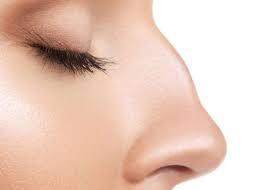The desire to have the Nose bump removed is one of the most common reasons for a nose job. The hump-nose deformation is particularly noticeable when viewing a face in profile. The facial harmony and the entire facial expression are influenced to a large extent by the hump, like with hardly any other nose shape. Many patients often have a Nose bump combined with a “hanging” tip of the nose. Many people see this nose shape as unattractive or even as an aesthetic problem. The desire for a corrective procedure to remove or remove or straighten the Nose bump (humped nose surgery), is great, especially when functional disorders also impair breathing or other symptoms occur. In most cases, the decision to have a rhinoplasty of the hump is aesthetically or psychologically motivated: The stress of looking unattractive with the excessive prominence of the nose or the nasal hump often has a negative effect on the self-esteem of those affected.
Although it is one of the most common operations on the nose, the removal or removal of the Nose bump is one of the most complicated types of nose surgery. It is therefore particularly important to turn to a specialist with many years of experience who you can trust. In Dr. medical Maiwald you will find exactly the expertise that a hump operation requires. We have a wealth of experience from over 3500 nose operations – including nose tip correction , nose reduction , nasal concha reduction and nostril changes– Empathy and individual advice, a professional team and innovative surgical techniques with stable long-term results await you in his practice for plastic and aesthetic surgery . As a specialist in ENT, Dr. medical Maiwald offers a number of other services, such as eyelid tightening or wrinkle treatments . Make an appointment today for the initial consultation and preliminary examination! Contact Dr. _ Record Maiwald!
Aesthetic sensitivity nasal bumps
The term humped nose refers to noses with a nose shape that are quite common, but are just as often perceived as annoying and the desire to remove the hump to want to bring with it: humped noses are noses whose bridge of the nose has not grown straight and has a hump in the upper third. The hump consists of excess cartilage and bone and in some cases can cause the upper bridge of the nose to bulge outwards. The cause of the outward bulge is primarily an asymmetric growth of the bone structure. But accidents can also cause deformation. In most humped noses, the tip of the nose is also bent downwards – the result is a “hanging” tip of the nose. This increases with age. In colloquial language, the terms “eagle nose” or “hawk nose” are also common for this nose shape.
Tension nose: functional disturbances caused by the hump
Remove Nose bump or remove Nose bump or straighten the bridge of the nose? Those affected play with this idea not only for aesthetic reasons, but also for medical reasons. Because in the middle of the face, a clear eye-catcher, the hump not only affects the profile and the overall impression visually, but is all too often accompanied by functional disorders: In addition to the deformation of the outer nose – consisting of the bony “nose pyramid” and a cartilaginous part underneath, which determines the formation of the tip of the nose and the shape of the nostrils – the inner nasal septum is also affected. This is often crooked or too long with humped noses. In addition, the nostrils are too narrow or the nostrils can be warped. Symptoms of such functional disorders are
- Significant impairments in breathing and nasal ventilation
- chronic inflammation of the sinuses
- increased nosebleeds
- a possibly impaired sense of smell.
The Nose bump OP
Before Nose bump removal
First and foremost, it is important for you to decide on your nose shape through a Nose bump surgery wanting to change, take enough time. In a consultation with our expert ENT doctor or surgeon, you should be able to express your ideas and wishes, but also be open to the doctor’s advice. A beautiful nose is always dependent on all the other physiognomic features on your face. In the end, the corrected nose should suit you and your face. In the consultation with examination, Dr. Joachim Maiwald, specialist in ENT medicine, determines your initial situation and compares it with your individual ideas for changing your nose. He explains which methods are possible in your specific case and the advantages and disadvantages of the individual techniques. It is important to us that you know as much as possible about the course of the treatment, therefore all questions and risks are clarified in advance. And so that you can better visualize the result of the procedure, Dr. Maiwald with the help of a computer simulation of before and after pictures, as you can see after the nasal hump removal could look like.
The preliminary examination is of particular importance for the patient: without it, there is no nasal hump surgery or treatment generally possible. Because the different tissue types of the nose (bone, cartilage, mucous membrane, skin) have their own healing and scarring behavior, the right surgical method must be selected in advance. In addition, the individual facial expressions of the patient have a significant influence on the course after the operation. It is therefore absolutely essential that the surgeon carry out a personal examination before every operation. Preliminary examinations prevent treatment errors, possible complications and wrong decisions. With the help of the nose operation explanation, you should also become aware of all the risks, possibilities and the scope of the treatment so that you can finally weigh up whether a nasal hump surgery is necessaryreally applies to you. The cost details can only be determined afterwards, since the respective operation effort is very individual.
Surgical methods for nose bump removal
Every nose is unique. Therefore, every surgical concept for a humped nose operation must be tailored to the individual. In general, the removal of the nasal hump is almost always part of a nose reduction, in which all enlarged areas of the nose (including the hump) are reduced. Depending on the initial findings (size and condition of the nose or hump) on the one hand and the desired correction on the other hand, different methods are used for humped nose surgery
- cusp removal
- File/rasp off
- Semi-open technique (delivery approach)
- Open technique (transcolumellar approach)
Nose hump removal without surgery: In addition to surgery, a non-surgical method could also be considered, provided the nasal hump is not too large. With this correction technique without surgery, fillers such as hyaluronic acid are injected. In this case, the change is achieved less by removing the hump than by covering it up. The correction with “Filler” must be repeated regularly in order to achieve a lasting result.
Hump removal / rasping
Nasal bumps form as a result of the swelling of bone and cartilage on the roof of the nose. If the hump is not too pronounced, but relatively subtle, it is possible to remove it using the rasping/filing technique. The bone rasp can be used to remove bumps in the nose by rasping off bone or cartilage substance in small, controlled steps. It is important to note that unless the bone is very thick, the roof would be quickly “grated through”.
Closed Technique
The closed technique is used especially for simple corrections. The operation is carried out entirely inside the nose. If a large or medium-sized nasal hump is to be removed, a “hammer and chisel” are used: In the first step, the cartilaginous roof of the nose is cut and lifted. A special chisel inserted by the surgeon is used to chisel away excess bone tissue on the roof of the nose. Then the bone parts on the side of the nose have to be moved back towards the middle line of the nose so that the so-called “open roof” is closed. To do this, the base of the bone must be broken with another chisel. “Piezo technology” is used as a new method of hump removal. This is an ultrasonic method coming from dentistry. The advantage is that there is less swelling and bruising. If a lot of tissue is broken down, further corrections may be necessary, such as this Reducing nostrils or nasal alar reduction.
Open Technique
The open technique for humped nose surgery is similar, but here a minimal mucous membrane incision is made inside the nose – i.e. invisible – and the skin of the bridge of the nose is severed (in the shape of an inverted V). Many surgeons prefer operating with an open approach, as this offers the advantage of working more safely and precisely under direct vision than with the closed variant. The open technique also ensures a more precise design of the tip of the nose.
Healing after nasal hump surgery
In general, the healing process is very different for every nose and for every person and depends on personal requirements. The healing time can sometimes be up to 12 months. Immediately after the operation, you will be affected by an inner and outer splint for about a week. But after this first week or at the latest 10 days after the nasal hump surgery. you can easily resume normal work activities. Care using special ointments or nasal oils also helps the mucous membranes to recover more quickly. Even if you have the feeling that the healing process is progressing well and the feeling is “normal” or the nose feels stable, you should refrain from exercising for about three to four weeks. Follow-up appointments are also essential: to avoid risks, you should make regular check-up appointments with your surgeon.
Also Read: Madelyn Cline Nose Job


